
Two forms of Analysis
The two most common forms of market analysis are fundamental analysis and technical analysis. Fundamental analysis involves analysing an asset using various parameters to measure the asset’s intrinsic value. These parameters include macroeconomic factors i.e. factors related to the overall economy and business conditions, as well as microeconomic factors i.e. factors that impact the movement of a specific asset. On the other end of the spectrum is technical analysis, which involves analysing market action by studying past movement of an asset and then using this information to predict the future price trajectory of the asset. The objective of this material is to familiarize the reader with various tools and indicators that can aid in studying the past price movement of an asset and then arrive at an informed decision to predict the future price movement.
Assumptions of Technical Analysis
Technical analysis is based on three important assumptions mentioned below:
Current price discounts every information
The assumption that current price discounts everything is possibly the most important premise of Technical Analysis. When applying Technical Analysis, the analyst must assume that the current price of an asset reflects every available piece of information that could possibly impact the demand and supply of the asset. The only exception to this is acts of god such as earthquakes, tsunamis etc. as such natural events cannot be anticipated beforehand. Nonetheless, the impact of such events, once they occur, is quickly discounted by the market and reflected in the price of an asset.
Price changes are not random
This is possibly the second most important assumption of Technical Analysis. When analysing an asset, the analyst must assume that price of the asset trends and that changes in price are not random. The basic premise behind this assumption is that unless an analyst accepts that price trends, there is no point in analysing an asset from a technical standpoint. In fact, the objective of Technical Analysis is to identify the prevailing trend of the asset and then to ride on that trend until evidence emerges that the trend is possibly reversing or has already reversed. There are three types of trend, each of which will be discussed later.
History tends to repeat itself
The next major premise of Technical Analysis is that history tends to repeat itself. We will be discussing a lot of price patterns later as we progress through the course. These price patterns have worked very well in the past and as such it must be assumed that they will work well in the future also. Recognizing a specific price pattern that is unfolding and knowing that such patterns have worked well in the past enables an analyst to use such information to predict the future movement of an asset. After all, while time keeps changing, the basic human psychology relating to greed and fear remains the same, thereby causing patterns to keep repeating.
What is a trend
We talked a little about trend in our earlier section. But what exactly do we mean by a trend? Put in simple words, a trend is the direction in which the price of an asset is heading. At any point in time, an asset can be in any one of the three trends: Up, down, or sideways. It is of foremost importance to first identify what the prevailing trend of an asset is as it informs the chart reader in terms of what to do and more importantly what not to do.
Trend is applicable to all time frame namely the short-term (ranging from minutes to hours), the medium-term (ranging from days to weeks), and the long-term (ranging from months to years). Different set of market participants will focus on the different types of trend. For example, a day trader will be more interested in knowing what the short-term trend is, while a long-term investor will be keener on knowing what the long-term trend of an asset is.
Successful trades can be made by identifying the trend as early as possible, and then riding on that trend until signs emerge that the trend is about to change or has already changed. ‘The trend is your friend’ is a very popular adage in the Technical Analysis community and it is hard to make any arguments against this adage given how well it has stood the test of time.
Different types of trend
As stated earlier, there are three types of trend namely the uptrend, the downtrend, and the sideways trend. We shall now discuss each of these types of trend in more detail.
Uptrend
An uptrend is a sequence of rising peaks and troughs wherein each peak is above its previous peak and each trough is above its previous trough. As long as this sequence of rising peaks and troughs continue, the uptrend is said to intact. The chart below shows how an uptrend looks like.
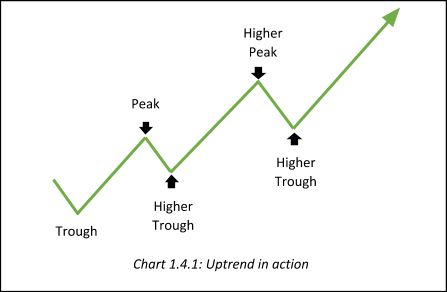
Downtrend
A downtrend is a sequence of lower peaks and troughs wherein each trough goes below the previous trough and each peak falls short of the previous peak. As long as this sequence continues, the downtrend is intact. The chart below shows how a downtrend looks like.
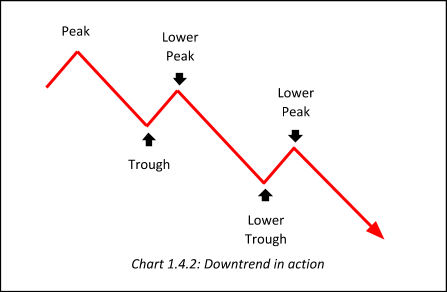
Sideways trend
A sideways trend is a pattern wherein there is no clearly identifiable trend and wherein prices move in a lateral band. As long as such sequence of uneven peaks and troughs continue, the sideways trend is said to be in effect. The chart below shows how a sideways trend looks like.
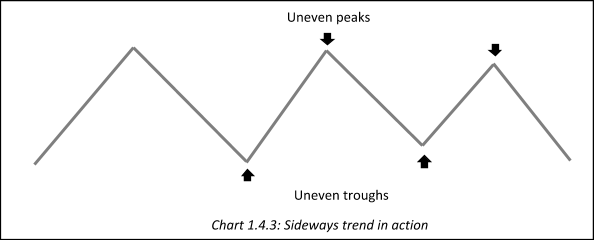
Given that there are only three types of trend - up, down, or sideways, at any point in time, there is an equal probability of an asset being in an uptrend, a downtrend, or a sideways trend. What this means is that there is a one-third probability that an asset is in an uptrend, one-third probability that an asset is in a downtrend, and one-third probability that an asset is in a sideways trend. Why this concept is important to understand will be talked about later when we discuss the concept of reversal in trend.
Also, at any point in time, different trends across different timeframes will simultaneously be in action. For example, the primary trend of an asset could be up, the secondary trend might be down, and the minor trend could be up. A reversal in minor trend from up to down would certainly influence short-term traders but is unlikely to have much bearing on the decisions of long-term investors, who are largely concerned with the direction of the primary trend. Having said that, while short-term traders are more interested in minor trends, they must also keep a watch on the secondary and primary trend. By the same logic, while long-term investors are more interested in primary trend, that does not mean that they can ignore the secondary and minor trends. Again, why these factors are important will be discussed in the relevant sections later.
Support and Resistance
After introducing the concept of trend and talking about the different types of trends, we will now turn our attention towards two of the most commonly used words in technical parlance: support and resistance. Even an individual who is not well versed with Technical Analysis will have heard about these two words given how frequently they appear in financial newspapers, media, etc. So, what exactly does one mean by support and resistance?
Well, in the earlier section, we talked about the three different trends: up, down, and sideways. We defined as uptrend as a sequence of rising peaks and troughs wherein each peak is above its previous peak and each trough is above its previous trough. In this sequence, each rising peak is called an area of resistance while each rising trough is called an area of support.
Support
A support can be defined as a region where the forces of demand exceed the forces of supply, causing the price of an asset to turn higher. Often, an area of support can be identified by looking at the past price action on a chart. It is usually the region where buying (demand) exceeded selling (supply), causing price to turn from down to up. Simply put, support is the lowest point reached before price reversed to the upside.
Resistance
A resistance can be defined as a region where the forces of supply exceed the forces of demand, causing the price of an asset to turn lower. Often, an area of resistance can be identified by looking at the past price action on a chart. It is usually the region where selling (supply) exceeded buying (demand), causing price to turn from up to down. Put in other words, resistance is the highest point reached before price reversed to the downside.
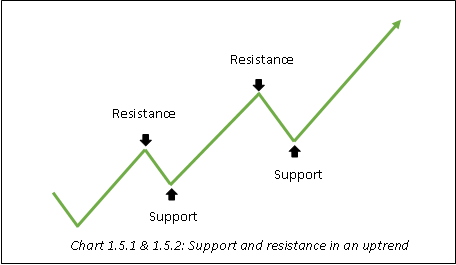
In the above chart, each high is called resistance while each low is called support. The above chart indicates an uptrend wherein resistances are getting higher and so are supports. Conversely, in a downtrend, each resistance gets lower and so does each support. It is of foremost importance to keep monitoring areas of support and resistance in case of each of the three trends discussed earlier. Why is this so important? Simply because support and resistance tell a lot about the strength of the prevailing trend.
Importance of support and resistance in an uptrend
In an uptrend, one would expect each high to go above its previous resistance and each low to be above its previous support. As long as this sequence of higher highs and lows continues, an uptrend is said to be intact and an individual who is long the asset can continue holding on to it or add more positions if necessary. However, in an uptrend, if after a sequence of higher highs and lows, the next high does not break above the previous resistance, it is an early warning that the uptrend could be weakening. If on the ensuing decline, the price breaks below the previous support, it is an indication of a reversal in trend. Such an event alerts an individual to cut down on his bullish bets on the asset and depending on his style of trading, open fresh short positions. The chart below illustrates why it is important to keep monitoring areas of support and resistance in an uptrend. There is also a concept called ‘change of polarity principle’, which states that a support once broken become a potential resistance on the ensuing rally.

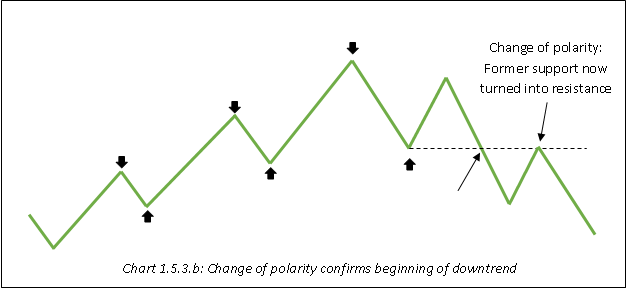
Importance of support and resistance in a downtrend
The role of support and resistance gets reversed in a downtrend. In a downtrend, each low breaks below its previous support and each high fails to exceed the previous resistance. As long as this sequence of lower lows and highs persists, a downtrend is said to be intact. However, in a downtrend, if after a sequence of lower lows and highs, the next low does not break below the previous support, it is an early warning that the downtrend could be weakening. If on the ensuing rally, the price breaks above the previous resistance, it is an indication of a reversal in trend. Such an event suggests that a new uptrend has begun and warrants establishing bullish bets in an asset. The chart below illustrates why it is important to keep monitoring areas of support and resistance in a downtrend. Confirmation of an uptrend occurs when on the ensuing decline price holds at or above the previous resistance which has now turned into a support (change of polarity principle).

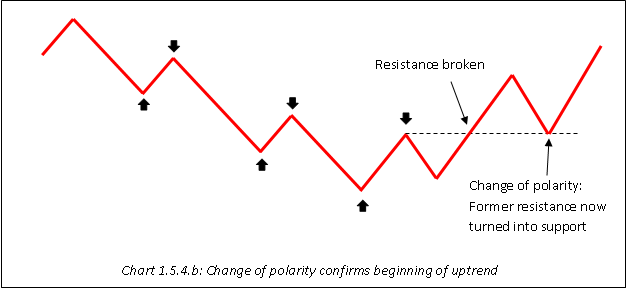
Other important support and resistance concepts
So far, we have discussed the meaning of support and resistance, their important in the confirmation of an uptrend and a downtrend, and their importance in hinting at a reversal of trend. Other important concepts relating to support and resistance are:
-
A support (resistance) once broken becomes a resistance (support) on the way up (down)
-
The number of times a support (resistance) is held, the greater is its significance when it eventually breaks
-
Round numbers act as important support and resistance
-
Keep an eye on volume activity when support (resistance) is either broken or held (we will discuss more on volume later)
-
Using price, volume, closing, or percent filter (or a combination thereof) can help to avoid whipsaws when a support or resistance is broken.
Two types of price scale:
On a technical chart, price is plotted along the vertical Y-axis while time is plotted along the horizontal X-axis. There are two types of price scales that are used by analysts. The first is the arithmetic scale and the other is the logarithmic scale.
Arithmetic price scale
This is the most commonly used form of price scale. An arithmetic price scale is plotted along the vertical Y-axis and represents equal distance between points along the Y-axis. In simple words, in an arithmetic scale, a change in price from ₹1 to ₹2, which represents a 1-point change, would be the same as a change in price from ₹100 to ₹101, again a 1-point change, which in turn would be the same as a change in price from ₹1000 to ₹1001. So, as we can see, there is an equal point change along each unit of the Y-axis.
Logarithmic price scale
A logarithmic price scale is plotted along the vertical Y-axis and represents equal percentage change between points along the Y-axis. For example, in a logarithmic scale, a change in price from ₹1 to ₹2, which represents a 100% rise, would be the same as a change in price from ₹100 to ₹200, which again represents a 100% rise, which in turn would be the same as a change in price from ₹1000 to ₹2000. So, as we can see, there is an equal percent change along each unit of the Y-axis.
What to use?
Naturally, the next question that comes into mind is which of the two price scales to use. Well, this again depends on the time frame that is being looked at. If the time frame that is being looked at is small and if the percent change in price is not large, then it wouldn’t make much difference when either arithmetic or logarithmic scale is used. However, if the time frame that is being looked at is large and if there has been significant percent change during that period, then by all means use logarithmic scale over an arithmetic scale
The above charts show Nifty’s movement over the past 12 months. The chart on the left shows Nifty on an arithmetic scale while the chart on the right shows Nifty on a logarithmic scale. Notice that with the percent change not large enough (approximately 30% change), it doesn’t make much difference whether arithmetic scale is used, or logarithmic scale is used. Both the charts appear nearly identical over a 12-month horizon with a limited percent change.

The above charts show Nifty’s movement over the past 2 decades. The chart on the left shows Nifty on an arithmetic scale while that on the right shows Nifty on a logarithmic scale. During this time period, Nifty has gained more than 1000%, which represents a big change. Because arithmetic scale represents an equal distance between points along the Y-axis, a move in Nifty from 1000 to 2000, which represents a 100% change, is of the same magnitude as a move from 10000 to 11000, which represents only a 10% change. Also, notice the steepness in the angle of ascent in both the charts. In the case of arithmetic chart, the initial movement is not quite clearly visible as it appears as a sort of sideways action (while in fact Nifty more than doubled during this period!), while the latter movement represents a steep rise in price. This poses a problem when it comes to drawing tools on the chart (tools will be discussed in detail in later topics). On the other hand, in the case of a logarithmic chart, notice how the initial movement is as clearly visible as the latter movement.
So, when it comes to deciding which price scale to use, consider the time frame of analysis. For a short-term trader, it does not make much of a difference as to whether arithmetic scale is used or logarithmic scale is used. For a long-term investor, however, logarithmic chart is more beneficial as a long-term investor would be more interested in percent change rather than absolute price change.
Different time frame
We conclude this introductory topic by discussing about another important area of analysis: using different time frames. On most charting platforms, a variety of time frames are available. The most common ones are: 1 minute, 5 minutes, 30 minutes, 1 hour, 4 hours, 1 day, 1 week, and 1 month. Different sets of individuals look at different time frames for their analysis. For example, an intraday trader would be more interested in minute and hourly charts, a swing trader would be more interested in daily and weekly charts, while an investor would be more interested in monthly charts.
Which time frame to you ?
Generally speaking, a trader or an investor would greatly benefit by using multiple time frames. Short-term traders would be better off by using weekly and hourly charts in addition to daily charts rather than basing their trading decision just on daily chart. This is because the chart of one larger degree tells a picture of the larger trend while that of one smaller degree provides early entry and exit signals. For example, a buy signal generated by a daily chart when the weekly chart is in a downtrend while minute chart is showing overbought condition is a weaker buy signal than a buy signal generated by a daily chart when both minute and weekly charts are pointing higher. Such type of cross reference is possible only when multiple time frames are used. By the same reason, investors who are interested in capturing larger percentage moves would benefit greatly if they keep an eye on weekly and quarterly charts in additional to monthly charts alone.
As a rule of thumb, a trader or an investor must keep a watch on both the nearest shorter time frame and the nearest longer time frame. By doing so, a trader can better decide what to do and more importantly what not to do. Using multiple time frames for analysing trends will be significantly more beneficial than using a single time frame for analysis.
Summary
-
There are two forms of analysis:
-
Technical Analysis, which is the study of price
-
Fundamental Analysis, which is the study of macro and micro economic factors.
-
-
The three assumptions of technical analysis are:
-
Current price discounts every information
-
Price changes are not random
-
History tends to repeat itself.
-
-
Trend is the direction in which the price of an asset is heading. There are three types of trend:
-
Uptrend
-
Downtrend
-
Sideways trend
-
-
Support can be defined as a region where the forces of demand exceed the forces of supply, causing the price of an asset to turn higher.
-
Resistance can be defined as a region where the forces of supply exceed the forces of demand, causing the price of an asset to turn lower.
-
Support once broken becomes a resistance on the way up, and vice versa.
-
There are two types of price scale:
-
Arithmetic, which represents an equal distance between points along the Y-axis
-
Logarithmic, which represents an equal percentage change between points along the Y-axis.
-
-
A short-term trader can use either arithmetic or logarithmic price scale, while a long-term investor would benefit more by using a logarithmic price scale.
-
A trader or an investor must keep a watch on both the nearest shorter time frame chart and the nearest longer time frame chart for better results.
Next Chapter
Comments & Discussions in
FYERS Community
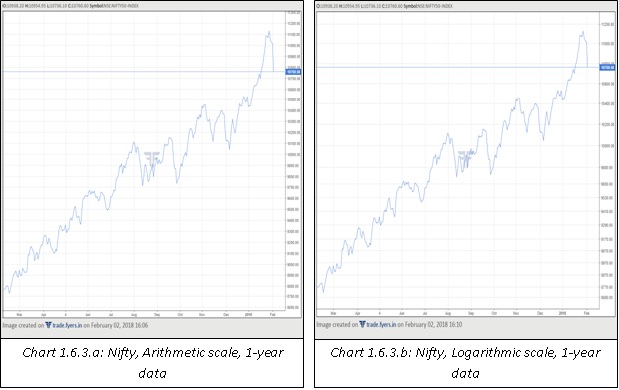
Janardhan commented on March 5th, 2019 at 9:20 PM
A very detailed explanation like Investopedia. Good one..
Shriram commented on January 26th, 2020 at 5:18 PM
Thank you Janardhan!
Luffy commented on March 14th, 2019 at 4:43 PM
It would be helpful if you could add videos to it
tejas commented on March 14th, 2019 at 4:56 PM
We'll do this in the future.
mohsinkhan commented on January 2nd, 2020 at 2:41 AM
start on your youtube channel school of stocks topics with video so its easily understanding..
Prashanth commented on April 8th, 2019 at 5:16 PM
Very useful. thank u so much sir
tejas commented on April 12th, 2019 at 7:30 PM
Glad you like it Prashanth!
Subhash Chandra Ghosh. commented on April 12th, 2019 at 11:56 AM
For the last few months, I devoted myself to understand the chart. During this process, I discovered the relation of a time frame and its variations on the chart. The movement of a trend is universal and it repeats every time when the situation arises. Even every shadow of a candle, either bull or, bear, on top or, bottom, it also tells a story. I followed and surprised. Every count is valuable to understand the chart at a different time frame. Solicit your advice so that I can take to my next level.
tejas commented on April 12th, 2019 at 7:40 PM
Hi Subash, I hope the module helps you understand charting in depth. If you have any specific queries, let me know.
Shashidhar commented on April 13th, 2019 at 9:19 PM
Hey Tejas,
I've been following you since long time. Determined to shift my to fyers. I pay really damn brokerage on monthly basis. Please clarify my one doubt. Please let me know where do i get you. I requested plenty of times same question i get no valid answer from your team or any one. Please help me. Waiting for your reply
tejas commented on April 15th, 2019 at 1:50 PM
Hi Shashidhar, I have replied to your email regarding Bracket Orders a while ago.
tejas commented on April 15th, 2019 at 1:51 PM
Good to know you've been following me. I write as much as I can. Hope it has helped so far.
Subhash Chandra Ghosh. commented on April 12th, 2019 at 7:54 PM
Thanks, and yes it is indeed helpful. Looking forward to analyzing your posts and, increase my knowledge.
tejas commented on April 15th, 2019 at 1:49 PM
That's great.
aman commented on May 15th, 2019 at 11:46 AM
Very informative and helpful.
tejas commented on January 4th, 2020 at 12:11 AM
Thx.
Rathan commented on June 13th, 2019 at 8:54 PM
Well informed.
Thanks
tejas commented on January 4th, 2020 at 12:12 AM
Thx.
Ramesh Kumar commented on June 23rd, 2019 at 8:06 PM
Hi Sir, thanks a lot for educating us, please seriously consider to provide as downloadable pdf materials,
tejas commented on January 4th, 2020 at 12:13 AM
Hey, we won't be doing that anytime soon. A PDF is not as interactive as this platform isn't it?
Pavan Kumar commented on September 7th, 2019 at 6:24 PM
Hi Sir,
Awesome information with detailed explanation.
I request you to provide an example of how to pick a stock for short term traders using weekly, hourly and daily charts.
tejas commented on January 4th, 2020 at 12:14 AM
Do read through this module, there's plenty of content that can help with that.
mohsinkhan commented on January 2nd, 2020 at 2:35 AM
AWESOME INFORMATION STARTS BY FYERS.
WITH DEMATE ACCOUNT OFFER STOCK MARKET DAY TRADING COURSE, THIS TYPES DEMATE ACCOUNT SCHEME OFFER OR DESIGN IN NEW YEAR.
tejas commented on January 4th, 2020 at 12:14 AM
Hey, Thx. We plan to interact more in offline events. Let's see how that goes. Thanks for your suggestions Mohsinkhan.
Saurabh Pathak commented on February 6th, 2020 at 8:22 PM
are these lessons available in pdf format, if not could you please create
Shriram commented on February 7th, 2020 at 7:06 AM
Hi Saurabh, at the moment, we have the modules only on our website.
SHIVAKUMARA L E commented on February 21st, 2020 at 1:38 PM
This is awesome work from fyers.
This education is very usefull for beginners and experienced traders
Thank u fyers
Shriram commented on February 21st, 2020 at 8:22 PM
Thank you Shivakumara for your valuable feedback!
Manoranjan commented on April 11th, 2020 at 4:39 PM
Wow really great it's great if u make all module in pdf we any time any where without internet I hope u make it soon
Shriram commented on April 12th, 2020 at 8:14 AM
Hi Manoranjan, thank you for the valuable feedback. At present, we have modules only on our website. Isn't it more interactive this way rather than just a PDF?